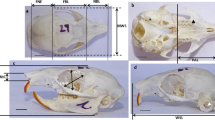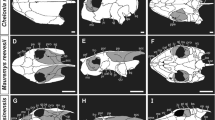Abstract
Currently, many aquariums and zoos around the world keep walruses in captivity. However, the presence of tusks in walruses creates difficulties in their maintenance and preservation of their health since they wear them down on the structure of the pools. In this study, the morphometric parameters of walrus skulls from captivity and wild of similar age were examined (35 skull measurements and 21 mandible measurements were taken). An examination of the skulls of three female walruses that were kept in the Moscow Zoo for 8, 11, and 22 years, respectively during the period of 1953–2005 was conducted. The tusks of one walrus, at the age of 4 years, were surgically removed, while the tusks of the others were not. There were slight deviations in the skull development of these walruses. The skull of captive walruses is slightly smaller in the mastoid processes and zygomatic arches, and facial part, and the lower jaw is smaller in width and symphysis circumference compared to wild walruses. The surface of the skull and lower jaw is smoother in comparison to wild walruses. Diseases such as odontogenic osteomyelitis, pulpitis, periodontitis, dental calculus and caries are observed. Due to frequent inflammations and surgical interventions, early fusion of sutures is noted, leading to skull deformities.






Similar content being viewed by others
REFERENCES
Clegg, I.L.K., Domingues, M., Ström, E., and Berggren, L., Cognitive foraging enrichment (but not non-cognitive enrichment) improved several longer-term welfare indicators in bottlenose dolphins, Animals, 2023, vol. 13, no. 2, p. 238. https://doi.org/10.3390/ani13020238
Cornell, L.H. and Antrim, J.E., Anesthesia and tusk extraction in walrus, J. Zoo Anim. Med., 1987, vol. 18, no. 1, pp. 3–6.
Curtis, A.A., Orke, M., Tetradis, S., and Van Valkenburgh, B., Diet-related differences in craniodental morphology between captive-reared and wild coyotes, Canis latrans (Carnivora: Canidae), Biol. J. Linn. Soc., 2018, vol. 123, no. 3, pp. 677–693. https://doi.org/10.1093/biolinnean/blx161
Fay, F.H., Ecology and Biology of the Pacific Walrus, Odobenus rosmarus divergens, Illiger, North American Fauna, Washington, D.C.: US Department of the Interior, Fish and Wildlife Service, 1982, vol. 74.
Fay, F.H. and Kelly, B.P., Development of a Method for Monitoring the Productivity, Survivorship, and Recruitment of the Pacific Walrus Population, Final Report, OCSEAP Study MMS 89-0012, Minerals Management Service, Anchorage, AK, 1989.
Gage, L.J., Negrini, R., Negrini, S., and Quihuis, D., Prevention of walrus tusk wear with titanium alloy caps, in Proc. 33rd Annu. Conf. of the International Association for Aquatic Animal Medicine, Albufeira, 2002.
Kapoor, V., Antonelli, T., Parkinson, J.A., and Hartstone-Rose, A., Oral health correlates of captivity, Res. Vet. Sci., 2016, vol. 107, pp. 213–219.
Kastelein R.A. and Mosterd P., The excavation technique for molluscs of Pacific walruses (Odobenus rosmarus divergens) under controlled conditions, Aquat. Mamm., 1989, vol. 15, no. 1, pp. 3–5.
Kastelein, R.A. and Wiepkema, P.R., A digging trough as occupational therapy for Pacific walruses (Odobenus rosmarus divergens) in human care, Aquat. Mamm., 1989, vol. 15, no. 1, pp. 9–17.
Kastelein, R.A., Gerrits, N.M., and Dubbeldam, J.L., The anatomy of the walrus head (Odobenus rosmarus). Part 2: Description of the muscles and of their role in feeding and haul-out behavior, Aquat. Mamm., 1991, vol. 17, no. 3, pp. 156–180.
Kim, J.Y., Zemnick, C., and Mao, J.J., Restoration of oral and craniofacial defects by stem cells and bioengineering approaches, in Current Therapy in Orthodontics, Nanda, R. and Kapila, S., Eds., 2010, pp. 359–370.
Kryukova, N.V., The method of age determination of the Pacific walrus (Odobenus rosmarus divergens) using the layered structure of functional teeth, Biol. Bull. (Moscow), 2014, vol. 41, no. 8, pp. 681–689. https://doi.org/10.1134/S1062359014080068
Kryukova N.V., Injuries and diseases found in Pacific walrus (Odobenus rosmarus divergens) at Cape Vankarem in 2010, Marine Mammals of the Holarctic, Proc. 8th Int. Conf., Moscow: Marine Mammals Council, 2015, vol. 1, pp. 246–248.
Kryukova N.V., Age-related changes in functional teeth in the Pacific walrus (Odobenus rosmarus divergens), Biol. Bull. (Moscow), 2017a, vol. 44, no. 7, pp. 820–825.
Kryukova N.V., Caries in teeth of the Pacific walrus, in 22nd Biennial Conference on the Biology of Marine Mammals, Abstracts of Papers, Halifax, Canada, 2017b, p. 217.
Kryukova, N.V., Legal regulation of the traditional (native) Pacific walrus harvest in Russia, Arkt. Sever, 2019a, vol. 36, pp. 24–41. https://doi.org/10.17238/issn2221-2698.2019.36.24
Kryukova, N.V., Know me, if you can: opportunities of the identification of walruses, Priroda, 2019b, vol. 8, pp. 20–29. https://doi.org/10.7868/S0032874X19080039
Levermann, N., Galatius, A., Ehlme, G., Rysgaard, S., and Born, E.W., Feeding behaviour of free-ranging walruses with notes on apparent dextrality of flipper use, BMC Ecol., 2003, vol. 3, no. 1, pp. 2–3. https://doi.org/10.1186/1472-6785-3-9
Lowry, L.F. and Fay, F.H., Seal eating by walruses in the Bering and Chukchi Seas, Polar Biol., 1984, vol. 3, pp. 11–18.
Marx, F.G., Hocking, D.P., Park, T., et al., Suction causes novel tooth wear in marine mammals, with implications for feeding evolution in baleen whales, J. Mammal. Evol., 2023, vol. 30, pp. 493–505. https://doi.org/10.1007/s10914-022-09645-1
Mason, G.J., Species differences in responses to captivity: stress, welfare and the comparative method, Trends Ecol. Evol., 2010, vol. 25, no. 12, pp. 713–721.
Mason, G.J., Stereotypies: a critical review, Anim. Behav., 1991, vol. 41, pp. 1015–1037.
Maykova, O.N., Problems and prospects of keeping walruses in captivity on the example of the Moscow Zoo, Graduate Work, Moscow: VSKHIZO, 2000.
McLaughlin, W.N.F., Boatman, C.J., Davis, E.B., and Hopkins, S.S.B., Total dental occlusal area as a feeding constraint feature in extant walruses (Odobenus rosmarus), and implications for the evolution of Molluscivory in Odobenidae, J. Mamm. Evol., 2022, vol. 29, no. 3, pp. 571–583. https://doi.org/10.1007/s10914-022-09603-x
McPhee, M.E. and Carlstead, K., The importance of maintaining natural behaviors in captive mammals, in Wild Mammals in Captivity: Principles and Techniques for Zoo Management, Kleiman, D.G., Allen, M., and Thompson, K., Eds., Chicago, Il: Univ. of Chicago Press, 2010, 2nd ed., pp. 303–313.
Mooney, M.P., Burrows, A.M., Smith, T.D., Losken, H.W., Opperman, L.A., Dechant, J., Kreithen, A.M., Kapuchu, R., Cooper, G.M., Ogle, R.C., and Siegel, M.I., Correction of coronal suture synostosis using suture and dura mater allografts in rabbits with familial craniosynostosis, Cleft Palate Craniofacial J., 2000, vol. 38, pp. 72–91.
Mori, T., Okumura, M., Miyamoto, T., Mwanza, T., Asano, K., Ogano, J., Oba, M., Tsunokawa, M., Nitto, H., and Fujinaga, T., A case of tusk extraction in walrus (Odobenus rosmarus) under general anesthesia with isoflurane, Jpn. J. Vet. Anesth. Surg., 1996, vol. 27, no. 2, pp. 57–63.
O’Regan, H.J. and Kitchener, A.C., The effects of captivity on the morphology of captive, domesticated and feral mammals, Mamm. Rev., 2005, vol. 35, pp. 215–230.
Proctor, M.R. and Meara, J.G., A review of the management of single-suture craniosynostosis, past, present, and future, J. Neurosurg. Pediatr., 2019, vol. 24, no. 6, pp. 622–631. https://doi.org/10.3171/2019.7.PEDS18585
Rozanova, E.I., Abramov, A.V., Smyshnov, A.V., and Naidenov, A.I., Extraction of the tusks in the walruses (Odobenus rosmarus), Marine Mammals of the Holarctic, Proc. 5th Intl. Conf., Moscow: Marine Mammals Council, 2008, pp. 465–467.
Sharma, R.K., Craniosynostosis, Indian J. Plastic Surg., 2013, 46, no. 1, pp. 18–27. https://doi.org/10.4103/0970-0358.113702
Siciliano-Martina, L., Light, J.E., and Lawing, A.M., Cranial morphology of captive mammals: a meta-analysis, Front. Zool., 2021, vol.18, p. 4. https://doi.org/10.1186/s12983-021-00386-0
Skibiel, A.L., Trevino, H.S., and Naugher, K., Comparison of several types of enrichment for captive felids, Zoo Biol., 2007, vol. 26, no. 2, pp. 371–381.
Slater, G.J., Dumont, E.R., and Van Valkenburgh, B., Implications of predatory specialization for cranial form and function in canids, J. Zool., 2009, vol. 278, no. 3, pp. 181–188.
Walrus Network. https://www.walrusnetwork.org.
Zaichenko, A.A., Kochenkova, O.V., Anisimova, E.A., Anisimov, D.I., and Lukin, O.Yu., Obliteration of serrated sutures of a human skull (review), Sarat. J. Med. Sci. Res., 2011, vol. 7, no. 3, pp. 567–572.
ACKNOWLEDGMENTS
We would like to express our immense gratitude to S.V. Kruskop and the Department of Theriology (Zoological Museum), and D.Y. Miloserdov for their comprehensive assistance (State Darwin Museum), O.A. Belonovich for translating the article, and the anonymous peer-reviewers.
Funding
This work was supported by ongoing institutional funding. No additional grants to carry out or direct thisparticular research were obtained.
Author information
Authors and Affiliations
Contributions
All authors contributed to the study. Idea, material preparation, data collection and analysis were performed by Natalia Kryukova. Data collection and veterinary analysis of teeth were made Daria Manukhova. Data collection were made Maria Slavina. The first draft of the manuscript was written by Natalia Kryukova and all authors commented on previous version of the manuscript. All authors read and approved the final version of the manuscript.
Corresponding author
Ethics declarations
CONFLICT OF INTEREST
The authors of this work declare that they have no conflicts of interest.
ETHICS APPROVAL AND CONSENT TO PARTICIPATE
This work does not contain any studies involving human and animal subjects.
Additional information
Publisher’s Note.
Pleiades Publishing remains neutral with regard to jurisdictional claims in published maps and institutional affiliations.
Rights and permissions
About this article
Cite this article
Kryukova, N.V., Manukhova, D.A. & Slavina, M.D. Deviations in the Development of Captivity Walrus (Odobenus rosmarus) Skull. Biol Bull Russ Acad Sci 51, 358–370 (2024). https://doi.org/10.1134/S106235902360321X
Received:
Revised:
Accepted:
Published:
Issue Date:
DOI: https://doi.org/10.1134/S106235902360321X




